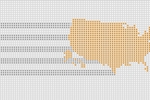Republican sweep: What it means for business
While key economic indicators are providing some optimism about the economic outlook, forecasts and US macroeconomic data have been all over the map in the months leading up to the election. Some worries about the labor market eased after September’s jobs report came in higher than expected. But job growth declined sharply in October due to the two hurricanes and a labor strike. This economic volatility and a tense geopolitical landscape add to the uncertainty around the election, just days before voters go to the polls.
If Republicans maintain control of the House and gain control of the Senate, a President Donald Trump would be able to push some of the most ambitious parts of his policy agenda. This could include corporate tax cuts and a wave of new tariffs.
A sweep would be a relative surprise to many business leaders. In our October 2024 Pulse Survey, 76% of the US executives responding agreed or strongly agreed there would be a divided government after the election. In addition, 77% expected an increase in executive orders and 75% expected both more regulation and litigation, regardless of who won.
A Republican sweep could reshape leadership agendas at most US companies. Trump campaigned on promises of tax cuts and tariff increases. Regarding tax cuts, he has called for making permanent expiring TJCA individual income tax and estate tax provisions. The Republican party platform also calls for maintaining TCJA business provisions and pursuing additional tax cuts. Trump has proposed lowering the 21% corporate income tax rate to 15% for companies producing goods in the United States. A Republican-controlled Congress in 2025 could use budget reconciliation to bypass the Senate’s 60-vote threshold for tax legislation, but it still must follow rules such as avoiding long-term deficit increases.
Trump has also proposed increasing federal revenues with a baseline tariff of at least 10% on all foreign-made goods and a 60% tariff on imports from China. With an aligned Congress, Trump would have significant power in terms of levying new tariffs and trade sanctions, which could hurt US competitiveness. Seventy-five percent of executives in our survey agreed or strongly agreed that a 10% universal tariff on imports would significantly hinder their growth. Even a modest 10% tariff on key categories like autos could push companies to revamp their supply chains. Moreover, the main burden would fall on consumers, as companies generally often pass tariffs along in the form of higher prices.
Stay tuned for updates on what the election outcome means for the regulatory landscape, including for financial services, healthcare and tech, media and telecom companies, as well as cybersecurity, tax legislation, trade and tariffs, artificial intelligence, climate and deals — and what executives can do to prepare for the new administration.
The road ahead: How the 2024 election will impact your business
Check back for more election updates and insights as they unfold.









